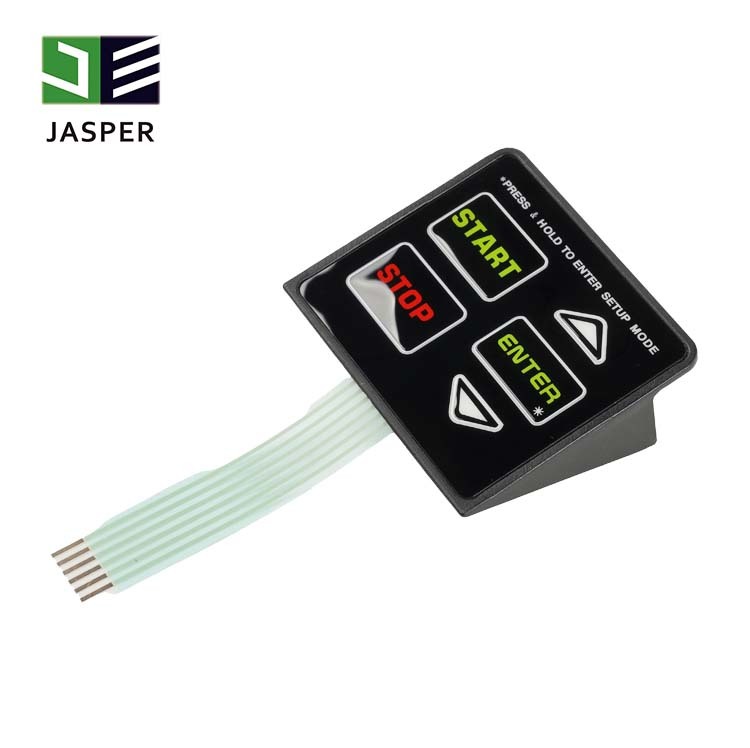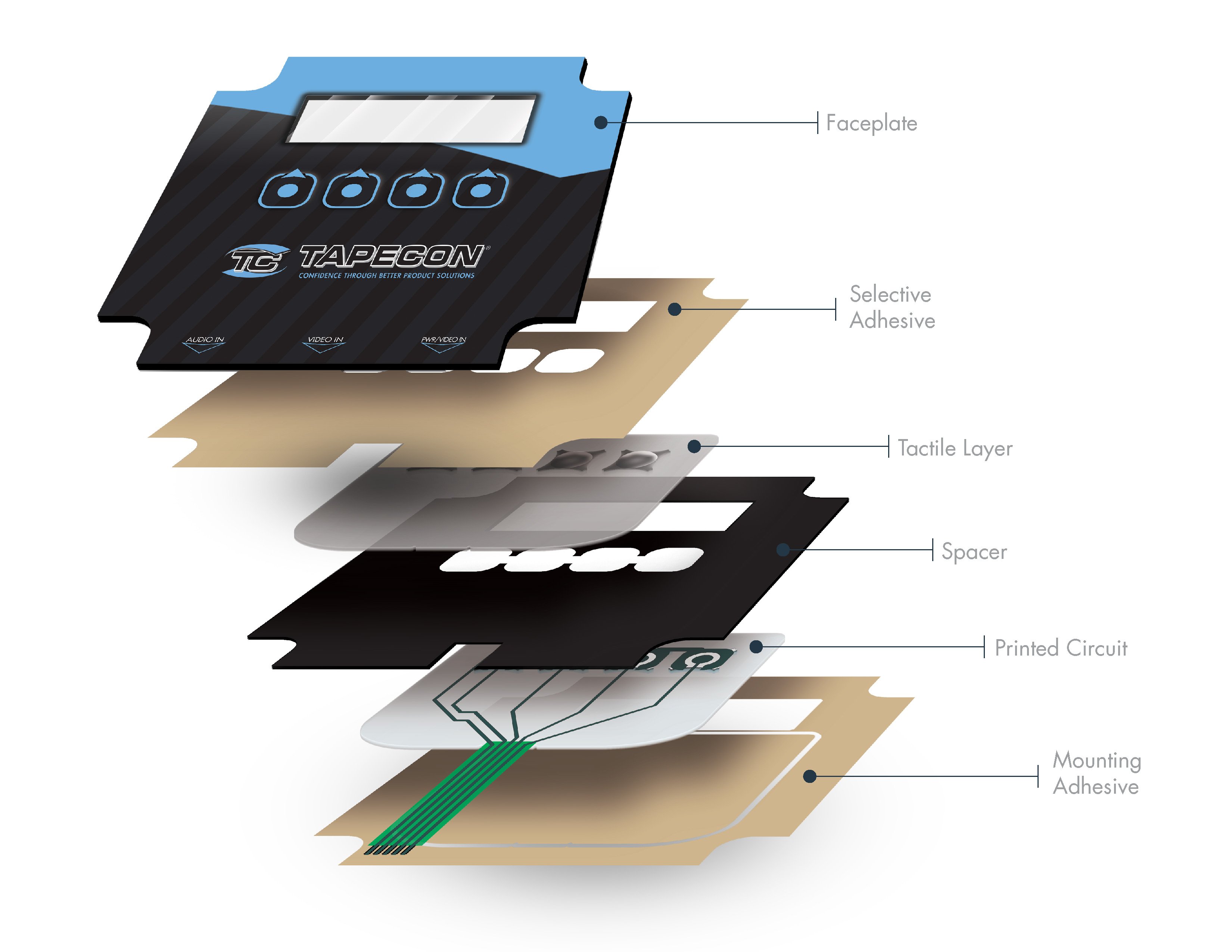The Production Refine Behind Membrane Layer Switch: What You Need to Know
The production process behind membrane layer switches over combines careful style, material selection, and quality assurance. It starts with understanding the complexities of membrane layer button design and advances via numerous phases, consisting of product choices and printing strategies. Each phase plays a crucial duty in making certain performance and resilience. The complexities of layer building and construction and the rigorous screening standards might reveal understandings that are not instantly noticeable. What lies past these fundamental aspects?
Comprehending Membrane Change Design
Membrane buttons may appear straightforward at very first look, their layout includes intricate considerations that guarantee capability and toughness. The design process starts with a detailed understanding of user requirements, including the interface's intended application and environmental elements. Ergonomics is a crucial element, as the design must help with simplicity of usage while making certain that tactile responses satisfies individual expectations.Moreover, the layering of elements, such as visuals overlays, adhesive layers, and conductive traces, should be exactly engineered. membrane switch. This split setup not only influences the button's responsiveness yet likewise impacts its longevity. Focus is offered to the sealing strategies employed to protect against moisture and dust, which could compromise performance. Furthermore, layout considerations reach visual appeals, where color pattern and visual clearness boost user experience. Eventually, the layout of membrane changes equilibriums performance, individual experience, and sturdiness, making sure that they satisfy the demands of various applications efficiently
Products Made Use Of in Membrane Layer Switch Production
When picking products for membrane layer button production, it is necessary to ponder both efficiency and toughness. The main materials consist of polyester and polycarbonate films, which give versatility and stamina. These movies are usually coated with sticky to assure correct bonding to substratums. Conductive inks, normally composed of silver or carbon, are important for creating electric links within the button, enabling dependable operation.Additionally, a protective layer, such as a difficult coat, is frequently related to enhance scrape resistance and longevity. The choice of backing material, such as acrylic or foam, can significantly influence the switch's responsive feel and total user experience. Additionally, different environmental variables, consisting of temperature level and humidity, ought to assist material choice to assure peak performance in certain applications. Inevitably, the appropriate combination of materials adds to the membrane button's capability and life-span, making informed options crucial for manufacturers.
The Printing Process: Creating Graphics and Text
The printing process in membrane switch manufacturing plays a considerable function in creating top notch graphics and message. Numerous visuals layout strategies are used to assure aesthetic allure and capability, while mindful ink option approaches are crucial for durability and performance. Recognizing these components is basic for attaining ideal cause membrane button style.
Graphic Design Techniques
Graphic layout methods play a vital duty in the printing process of membrane layer buttons, as they define just how graphics and message will eventually show up on the end product. Effective visuals design entails the calculated use typefaces, layouts, and shades to improve readability and visual charm. Designers usually use vector graphics for scalability, ensuring that photos remain sharp at numerous sizes. In addition, attention to comparison and alignment is crucial, as it influences individual communication and aesthetic top quality. The incorporation of branding components, such as logos, need to be taken care of with like keep brand stability. On the whole, thoughtful graphic style strategies contribute significantly to the capability and beauty of membrane layer buttons, impacting individual experience and item performance.
Ink Selection Techniques
Picking the appropriate ink is necessary for attaining the desired visual top quality and resilience in membrane button manufacturing. Numerous ink types are utilized, including solvent-based, water-based, and UV-curable inks. Each kind supplies distinctive characteristics, such as attachment, resistance, and adaptability to ecological factors. Solvent-based inks are frequently favored for their sturdiness and lively shades, while water-based inks are a lot more eco pleasant yet might have restrictions in bond. UV-curable inks supply fast treating and robust performance. Furthermore, color matching techniques guarantee that the selected inks straighten with layout requirements. Inevitably, the option of ink need to think about aspects such as application technique, substrate compatibility, and end-use requirements to attain premium outcomes in membrane switch graphics and text.
Layer Building And Construction and Setting Up

Product Selection Refine
A cautious option of products is important in the manufacturing process of membrane layer switches, as it straight affects capability and durability. The primary materials used include polyester, polycarbonate, and different conductive inks. Polyester is commonly preferred for its superb resistance to chemicals and abrasion, making it ideal for harsh environments. Polycarbonate, on the other hand, offers exceptional clearness and effect resistance, which is useful for applications needing exposure and toughness. Conductive inks, normally made up of silver or carbon, are crucial for producing trustworthy electric pathways. Additionally, the choice of adhesive products influences the general stability of the switch - membrane switch. Assessing factors such as environmental direct exposure, responsive comments, and aesthetic requirements overviews suppliers in choosing the most effective materials for their specific applications
Layer Attachment Methods
Adhering layers in membrane button building is an important process that assures performance and longevity. Various attachment methods are employed to safeguard suitable bonding between layers, which typically consist of using adhesives, heat, and stress. Pressure-sensitive adhesives (PSAs) are typically utilized for their simplicity of application and immediate bonding capacities. Furthermore, thermal bonding techniques can be used, where heat is made use of to trigger glue buildings, protecting a strong bond. The option of adhesion technique largely relies on the materials included and the specific application needs of the membrane button. Correct positioning and consistent application of adhesives are necessary to prevent flaws, safeguarding the switch runs effectively throughout its designated life-span.
High Quality Control Actions
Guaranteeing quality assurance throughout the layer building and construction and assembly of membrane buttons is important for preserving efficiency and reliability. This process normally involves several important measures, including complete inspections at each stage of production. Makers make use of advanced testing techniques, such as peel examinations and attachment analyses, to verify the integrity of layer bonds. Furthermore, visual examinations are conducted to identify any type of defects in printing or material variances. Ecological problems, such as temperature level and moisture, are carefully kept track of to ensure suitable healing and attachment. Normal calibration of tools aids maintain exact production requirements. By carrying out these top quality control actions, suppliers can substantially lower the threat of product failure, guaranteeing that the last membrane layer changes satisfy the needed specifications and customer assumptions.
Checking and High Quality Control Steps

Innovations in Membrane Layer Change Technology
As advancements in modern technology remain to develop, membrane buttons are benefiting from innovative growths that improve their functionality and customer experience. One significant development is the integration of capacitive touch modern technology, which permits even more receptive and intuitive interface. This change not only enhances aesthetic appeals but additionally decreases mechanical damage, prolonging the lifespan of the switches.Additionally, improvements in graphic overlay products have actually caused improved toughness and resistance to environmental aspects such as moisture and UV light. These products currently provide boosted clearness and illumination, further raising the aesthetic appeal.Furthermore, the consolidation of clever technology is transforming membrane layer switches right into interactive control board, making it possible for connectivity with IoT tools. This connection fosters a seamless user experience, paving the means for applications in various markets, from medical care to consumer electronic devices. Jointly, these innovations setting membrane layer switches as vital parts in modern device style.
Regularly Asked Inquiries
The length of time Does the Membrane Layer Switch Over Manufacturing Process Take?
The period of the membrane layer switch manufacturing process can vary significantly. Variables such as intricacy, materials used, and production quantity influence timelines, with common production ranging from a couple of days to a number of weeks for conclusion.
What Are the Usual Applications for Membrane Layer Buttons?
Membrane layer buttons are commonly utilized in various industries, including automobile controls, home home appliances, medical gadgets, and consumer electronics (membrane switch). Their flexibility and toughness make them excellent for applications calling for straightforward user interfaces and trusted efficiency in varied atmospheres
Can Membrane Switches Be Customized for Specific Needs?

What Is the Life-span of a Typical Membrane Change?
The life-span of a typical membrane switch varies, however usually, it varies from 1 to 5 million cycles. Factors such as usage, atmosphere, and material high quality substantially affect resilience and overall performance in time.

Are Membrane Layer Switches Over Eco Pleasant?
The ecological friendliness of membrane switches varies. Some products made use of might not be recyclable, while others can be environment-friendly. The general effect depends upon manufacturing products and methods, requiring careful factor to consider throughout choice and disposal. The manufacturing process behind membrane layer changes combines cautious design, product option, and high quality control. It begins with recognizing the details of membrane switch layout and advances through various phases, including product options and printing techniques. When picking products for membrane button manufacturing, it is important to ponder both efficiency and resilience. A mindful choice of materials is crucial in the manufacturing process of membrane layer switches, as it straight influences capability and sturdiness. The choice of bond method mainly depends on the materials entailed content and the particular application needs of the membrane button.